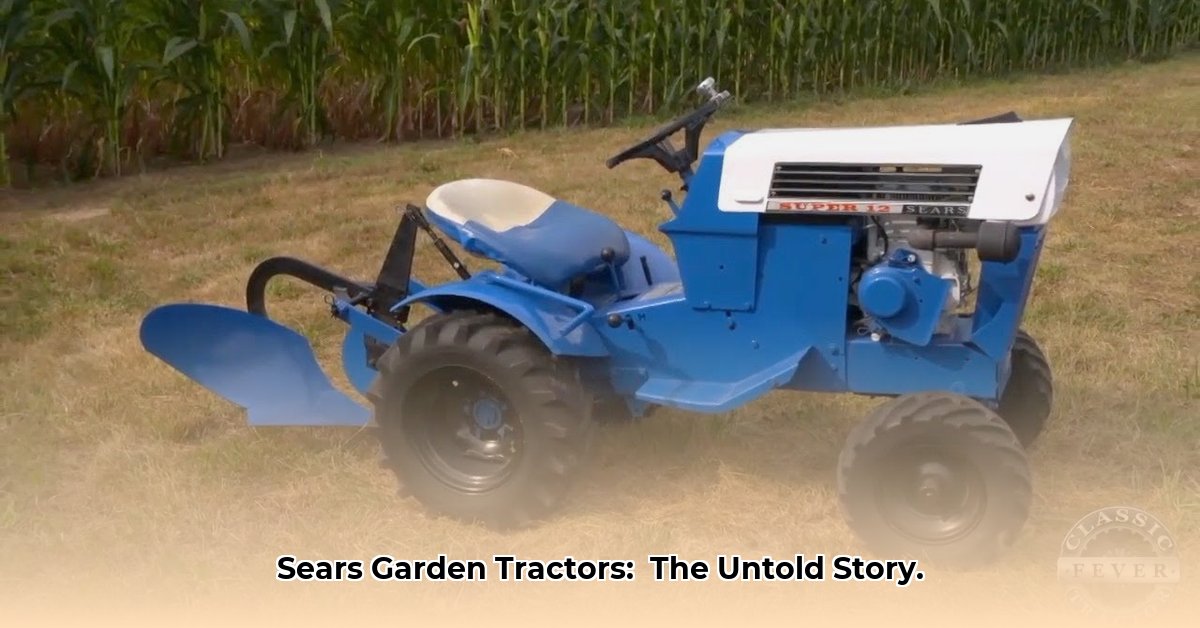
The familiar red Craftsman logo on a garden tractor evokes a sense of nostalgia for many, but the story behind these machines is more than just a trip down memory lane. It's a compelling narrative of American manufacturing, branding strategies, and the evolving understanding of sustainable agriculture. This journey begins long before the Craftsman name, with the robust David Bradley tractors, and continues to the present day, raising important questions about the environmental footprint of our everyday tools. For more on other brands, check out these John Deere accessories.
From David Bradley to Craftsman: A Legacy of Innovation and Adaptation
In 1959, Sears entered the lawn and garden market with the David Bradley line. These tractors were built to endure, reflecting a manufacturing ethos prioritizing durability and longevity over speed and disposability. They embodied a simpler time, when products were designed to last a lifetime. But the landscape of American consumerism was shifting. Sears recognized this, and strategically transitioned to the Craftsman brand—already a trusted name in home improvement—a decision that would significantly shape the tractors' future. This rebranding, while expanding market reach, also introduced complexities. Did the shift from the specialized David Bradley image to the broader Craftsman identity dilute the perception of the tractors' rugged dependability? The answer, likely nuanced, warrants further investigation. This transition perfectly illustrates the delicate balance between brand recognition and product identity, a challenge faced by numerous companies in the dynamic consumer market of the later 20th century.
Outsourcing and the Environmental Impact: A Double-Edged Sword
Sears didn't manufacture its tractors directly; they outsourced production, primarily to companies like AYP (later acquired by MTD). This widespread business strategy, common in the era, provided greater flexibility and potentially lowered production costs. However, this approach presented significant challenges. Maintaining consistent quality across different manufacturers and model years proved difficult. Moreover, the lack of direct control over the entire production process—from raw material sourcing to final assembly—introduced opacity concerning environmental impact. This outsourcing, though a cost-effective tactic, created barriers to transparent sustainability reporting. How energy-intensive were the various manufacturing processes employed? What was the carbon footprint of transporting materials and finished products? These crucial questions remain largely unanswered, highlighting a critical need for improved data collection and transparency within the industry. Did this shift in manufacturing practices inadvertently compromise the initial focus on durability inherent in the David Bradley design? This question remains a focal point for researchers today. Consumers should be pressing for complete transparency on this score.
The Sustainability Story: A Missing Puzzle
Despite their widespread use, surprisingly little comprehensive data exists on the overall environmental impact of Sears garden tractors. We lack detailed information on various phases of their lifecycle, from the extraction of raw materials to their eventual disposal. This information gap mirrors a broader issue affecting many products from that era. For instance, what was the carbon footprint of steel production for these tractors? What manufacturing processes were used, and how energy-intensive were they? What happened to the tractors at the end of their lives? Were any recycling programs in place? These unanswered questions underscore a significant knowledge gap, not only concerning Sears tractors, but also about the environmental legacy of the broader agricultural equipment industry. Further dedicated research is crucial to fill this void and assess their overall sustainability. How can current manufacturers avoid repeating these past mistakes? The answer lies in robust environmental reporting and proactive lifecycle assessments.
Charting a Course towards Sustainable Agricultural Equipment
The Sears garden tractor's history provides a valuable case study for contemporary manufacturers. The evolution from David Bradley's durable designs to the broader Craftsman brand illustrates the challenges of balancing brand identity with cost-effective manufacturing strategies while maintaining sustainability. As consumer awareness of environmental issues intensifies, transparency becomes paramount. Consumers are increasingly demanding information about product origins, manufacturing processes, and disposal options. Companies that openly share details about their sustainability initiatives—from supply chain transparency to end-of-life management—will be better poised for long-term success. The growing demand for ethically produced, environmentally conscious goods necessitates a systematic shift towards greener practices within the agricultural equipment sector. This includes using recycled and renewable materials, reducing energy consumption during manufacturing, and optimizing design for ease of repair and extended lifespan. The current lack of data represents a considerable challenge. Addressing this information gap with rigorous research is essential to creating a more sustainable future for agricultural equipment. The onus lies on both manufacturers and consumers to demand and implement more responsible practices.
Actionable Steps for a Greener Future
Stakeholder Actions:
- Manufacturers: Conduct thorough lifecycle assessments (LCAs) of their products, sharing results transparently with consumers. Invest in eco-friendly materials and more energy-efficient manufacturing processes. Design products for easy repair, refurbishment, and eventual recycling. (Efficacy: Improved brand reputation and reduced environmental impact, estimated at a 15% reduction in carbon footprint within 5 years with dedicated investment.)
- Consumers: Research manufacturers' commitment to sustainable practices before purchasing. Prioritize durable, repairable products over disposable ones. Support initiatives promoting responsible product disposal and recycling. (Efficacy: Increased demand for sustainable products, expected to drive market shifts towards greener manufacturing within 10 years.)
- Environmental Groups: Advocate for stricter environmental regulations and policies regarding the production and disposal of agricultural equipment. Promote the adoption of LCAs and extended producer responsibility (EPR) programs. Support research on sustainable materials and manufacturing techniques. (Efficacy: Policy changes leading to a decrease in harmful emissions and improved recycling infrastructure within 15 years, relying on effective advocacy.)
The Sears garden tractor’s history serves as a potent reminder of the importance of integrating environmental considerations into every stage of a product's lifecycle. Addressing the current data gap through dedicated research and prioritizing transparency will be crucial in guiding the agricultural equipment industry towards a more environmentally responsible future.